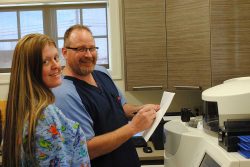
Annual Wellness Exam
Annual wellness examinations for women are an essential component for the overall well-being and health of women. Women have unique needs that should be examined annually. Even when women feel healthy, wellness exams allow Dr. Ward to:
- Review health history.
- Assess vital signs.
- Review patient lifestyle.
- Screen for disease.
- Update vaccinations.
- Assess the risk of potential medical problems (especially for women over 50 years old).
- Discuss any health issues that may be surfacing.
Dr. Ward has always been an advocate of preventative healthcare, which is primarily done through wellness checkups. Through these check-ups, an active lifestyle will be encouraged.
Dr. Ward’s “Lets get healthy together” program has an entire section of this website dedicated to provide healthy recipes and exercises to inspire patients to live healthy.
AGES OF IMPORTANCE
There are significant examination timeframes for women that are recommended by the American Congress of Obstetricians and Gynecologists (ACOG). They are:
- A woman’s first reproductive health visit should take place between ages 13 and 15. This first reproductive health visit is typically a simple discussion between patient and doctor.
- An annual breast and pelvic exam should begin at age 19.
- Pap tests that screen for cervical cancer should begin at age 21.
- Annual mammogram screenings for breast cancer should begin at age 40.
- Regular screening for colorectal cancer with a colonoscopy for women should begin at the age of 50.
These preventative screening tests identify risk factors of cancer and other disease. Early detection saves lives!
CHECKUP ASSESSMENT
In a routine wellness examination, Dr. Ward will take the time to listen to any concerns and also assess:
- General Appearance: By talking with a patient, Dr. Ward will gather a lot of information. He will assess mental quickness/memory, skin appearance, balance and coordination to determine if risk factors for disease exist.
- Vital Signs: Vital signs include blood pressure, heart rate, respiration rate, and body temperature. He will look for signs of hypertension and other risk factors for disease.
- Heart Exam: By listening to a patient’s heart with a stethoscope, Dr. Ward may detect an irregular heartbeat, heart murmur or other symptoms of heart disease.
- Lung Exam: Dr. Ward will also use a stethoscope to listen for signs of lung disease. If he hears wheezing, crackling, or diminished breath sounds, he may want to explore the lungs further.
- Head and Neck Exam: The throat and tonsils will be checked for normalcy as well as the ears, nose, sinuses, eyes, lymph nodes, thyroid, and carotid arteries. In case of abnormally, Dr. Ward may continue testing, like checking blood hormone levels to identify thyroid problems.
- Abdominal Exam: Dr. Ward will use a stethoscope again to listen for bowel sounds, and palpitate the abdomen and liver to detect any tenderness. Dr. Ward may also tap abdomen to see if there is a presence of abdominal fluid.
- Neurological Exam: Nerves, muscle strength, reflexes, balance, and the patient’s mental state may also be assessed with a neurological exam. This may include tapping just under the kneecap with a special device to verify normal reflexes.
- Dermatological Exam: A closer look at a patient’s skin and nails will allow Dr. Ward to determine if there are dermatological problems or if it is a manifestation of disease somewhere else in the body.
- Extremities Exam: A patient’s pulse is checked in the arms and legs and further examination of the patient’s joints can assess abnormalities.
- Breast Exam: A breast exam to detect abnormal lumps may be performed as part of the annual wellness exam for women. As part of this exam, the lymph nodes in the underarm area, the breasts and nipples will be evaluated for any visual abnormalities.
- Pelvic Exam: A pelvic exam may be performed to examine the vulva, vagina and cervix. Routine scans for sexually transmitted infections are often done. To screen for cervical cancer, a Pap test and HPV test may also be completed to assess the risk for cervical cancer.
LABORATORY TESTS

Although there are no standard laboratory tests during a wellness check or annual physical exam, some additional test may be ordered if there are concerns noted during the physical. Routine tests may include:
- Complete Blood Count (CBC): This test is used to measure several components of the blood, including red blood cells, to detect disorders, including anemia, infection and leukemia.
- Blood Sugar: If a patient has risk factors for diabetes, a blood sugar test will likely be ordered. At age 45, blood sugar tests may be ordered more often.
- Chemistry Panel (CP): This groups of tests help evaluate general health. Among other things, the body’s electrolyte balance will be reviewed along with the status of several major body organs.
- Lipid Panel: The lipid panel tests cholesterol levels and is recommended every 4 to 6 years, according to the American Heart Association. Dr. Ward may order them more frequently if there are specific symptoms or risk factors.
- Pap Smear: The Pap test checks for cervical cancer. The cervix is the lower part of the uterus that opens at the top of the vagina. Cells scraped from the opening of the cervix are collected and then sent to a lab for examination.
- Urinalysis (UA): Urinalysis is a test that evaluates urine. The test is used to assess disorders, such as urinary tract infection, kidney disease and diabetes.
Conclusion
Annual wellness exams for women are key to preventative medicine and will help achieve optimal health. Annual screenings can catch disease in its infancy when it is most curable. As we say frequently, early detection saves lives!
If you are a woman who hasn’t had a wellness exam for a while, call Dr. Ward for an appointment without delay.

